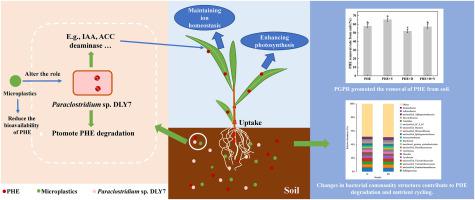当前位置:
X-MOL 学术
›
J. Clean. Prod.
›
论文详情
Our official English website, www.x-mol.net, welcomes your feedback! (Note: you will need to create a separate account there.)
The role of microplastics in the process of Paraclostridium sp. DLY7-assisted phytoremediation of phenanthrene contaminated soil
Journal of Cleaner Production ( IF 11.1 ) Pub Date : 2024-03-21 , DOI: 10.1016/j.jclepro.2024.141845 Xiancao Chen , Zhiman Li , Xiaoge Zhang , Fenyan Chen , Yalan Zhu , Chunfeng Guan , Qian Li
Journal of Cleaner Production ( IF 11.1 ) Pub Date : 2024-03-21 , DOI: 10.1016/j.jclepro.2024.141845 Xiancao Chen , Zhiman Li , Xiaoge Zhang , Fenyan Chen , Yalan Zhu , Chunfeng Guan , Qian Li

|
Microplastics can absorb polycyclic aromatic hydrocarbons (PAHs), decrease the bioavailability of pollutants, alter the soil microbial community, and thus might affect the dissipation of soil pollutants. However, whether microplastics could alter the remediation efficiency of PGPR-assisted plants for PAHs-contaminated soil has not been studied. This study assessed the remediation potential of PGPR exhibiting phenanthrene (PHE) degradation ability in assisting maize for PHE-contaminated soil. Especially, the role of microplastics involved in this remediation process was also investigated. The results showed that strain sp. DLY7 DLY7) significantly increased the PHE removal efficiency (63.4%) from soil by maize and reduced the content of PHE in maize leaves and roots with no microplastics addition. However, the presence of microplastics significantly inhibited the PHE removal from soil and increased the PHE accumulation in maize issues, in comparison with PHE + DLY7 treatment. Microplastics also significantly reduced soil sucrase and alkaline phosphatase activities, and the content of soil nitrate nitrogen and ammonium nitrogen under non-inoculation with strain conditions. Inoculation with strain DLY7 also altered the rhizosphere soil microbial community, enriched some beneficial bacteria and increased activities of some crucial soil enzymes, thus facilitating PHE removal from soil. On the whole, compared with conventional soil contamination remediation studies, this study innovatively pointed out that microplastics significantly reduced the removal efficiency of soil PHE and increased the uptake of PHE by maize in the PGPR-assisted phytoremediation process. However, the effects of microplastics on microorganisms might be related to the particle size, concentration and type of microplastics in the environment, which would be studied in our future research. These findings proposed new perspectives for revealing the role of microplastics on the efficiency of microbe-assisted phytoremediation of PAHs-contaminated soil.
中文翻译:

微塑料在副梭菌生长过程中的作用。 DLY7辅助植物修复菲污染土壤
微塑料可以吸收多环芳烃(PAHs),降低污染物的生物有效性,改变土壤微生物群落,从而可能影响土壤污染物的消散。然而,微塑料是否会改变PGPR辅助植物对PAHs污染土壤的修复效率尚未得到研究。本研究评估了具有菲 (PHE) 降解能力的 PGPR 在协助玉米修复 PHE 污染土壤方面的潜力。特别是,还研究了微塑料在修复过程中的作用。结果表明菌株 sp。 DLY7(DLY7)显着提高了玉米对土壤中 PHE 的去除效率(63.4%),并在不添加微塑料的情况下降低了玉米叶和根中 PHE 的含量。然而,与 PHE + DLY7 处理相比,微塑料的存在显着抑制了 PHE 从土壤中的去除,并增加了玉米中 PHE 的积累。微塑料还显着降低了不接种菌株条件下土壤蔗糖酶和碱性磷酸酶活性以及土壤硝态氮和铵态氮含量。接种菌株 DLY7 还改变了根际土壤微生物群落,丰富了一些有益细菌并增加了一些关键土壤酶的活性,从而促进了 PHE 从土壤中的去除。总体而言,与常规土壤污染修复研究相比,本研究创新性地指出,在PGPR辅助的植物修复过程中,微塑料显着降低了土壤PHE的去除效率,并增加了玉米对PHE的吸收。然而,微塑料对微生物的影响可能与环境中微塑料的粒径、浓度和类型有关,这将是我们未来研究的重点。这些发现为揭示微塑料对微生物辅助植物修复多环芳烃污染土壤效率的作用提供了新的视角。
更新日期:2024-03-21
中文翻译:

微塑料在副梭菌生长过程中的作用。 DLY7辅助植物修复菲污染土壤
微塑料可以吸收多环芳烃(PAHs),降低污染物的生物有效性,改变土壤微生物群落,从而可能影响土壤污染物的消散。然而,微塑料是否会改变PGPR辅助植物对PAHs污染土壤的修复效率尚未得到研究。本研究评估了具有菲 (PHE) 降解能力的 PGPR 在协助玉米修复 PHE 污染土壤方面的潜力。特别是,还研究了微塑料在修复过程中的作用。结果表明菌株 sp。 DLY7(DLY7)显着提高了玉米对土壤中 PHE 的去除效率(63.4%),并在不添加微塑料的情况下降低了玉米叶和根中 PHE 的含量。然而,与 PHE + DLY7 处理相比,微塑料的存在显着抑制了 PHE 从土壤中的去除,并增加了玉米中 PHE 的积累。微塑料还显着降低了不接种菌株条件下土壤蔗糖酶和碱性磷酸酶活性以及土壤硝态氮和铵态氮含量。接种菌株 DLY7 还改变了根际土壤微生物群落,丰富了一些有益细菌并增加了一些关键土壤酶的活性,从而促进了 PHE 从土壤中的去除。总体而言,与常规土壤污染修复研究相比,本研究创新性地指出,在PGPR辅助的植物修复过程中,微塑料显着降低了土壤PHE的去除效率,并增加了玉米对PHE的吸收。然而,微塑料对微生物的影响可能与环境中微塑料的粒径、浓度和类型有关,这将是我们未来研究的重点。这些发现为揭示微塑料对微生物辅助植物修复多环芳烃污染土壤效率的作用提供了新的视角。



























 京公网安备 11010802027423号
京公网安备 11010802027423号